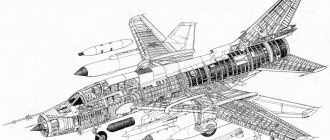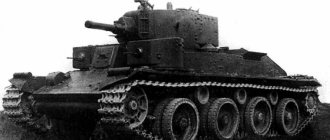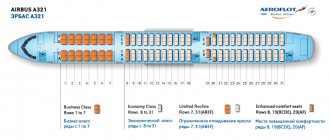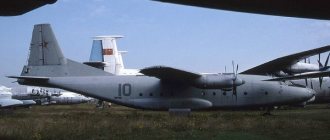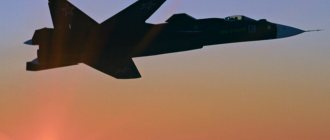MiG-41: Doomsday fighter
Author Alexander Artamonov
03.11.2017 12:42
Copyright
The new MiG-41 fighter, which is being developed in Russia, may enter testing as early as 2020. At the same time, the MiG-31 interceptors currently in service successfully cope with their tasks and will not become obsolete until the 2030s.
38 shared
MiG-41: the most secret project of the military-industrial complex
On October 26, MiG-31BM long-range interceptor fighters covered missile-hazardous areas during exercises in the skies of the Subpolar Urals. Crews of two air regiments stationed in the Perm and Krasnoyarsk territories took part in the air maneuvers.
More than 40 aircraft also performed mid-air refueling at high altitude. This exercise is one of the most difficult for pilots of military equipment, as it involves the ability to keep the aircraft at a distance of 10-15 meters from the Il-78 tanker, despite aerodynamic disturbances and the obvious threat of collision.
The MiG-31 has been on combat duty for a little less than half a century, or rather, since 1975. The fighter that saw the light of day at the Mikoyan design bureau immediately became unique in a number of parameters: it was the first to be equipped with a phased antenna array, allowing it to “hold” up to 24 targets, with active tracking of at least eight. In addition, he received good weapons - a long-range air-to-air missile. This made it a killer of a number of targets, including even satellites in low Earth orbit. Another impressive characteristic of the Air Force veteran is his incredible speed and range.
But there is a limit to everything. Therefore, back in the 1990s, the leadership of the military aviation industry decided to create a fundamentally new aircraft that would develop the performance characteristics of the MiG-31. The future machine received the code name “Project 701”. But during the Yeltsin era, Russia did not need new machines to protect its own airspace, so the project was frozen.
And now the MiG-41 is underway again. It is curious that the order came from the country's leadership, and is not a creative proposal from the designers of the Mikoyan Design Bureau. Also immediately attracting attention is the strict fixation of the deadlines for the execution of the defense order: it is expected that the vehicle will be put into service as early as 2025.
The project has long been revived, since about a month ago it became known about its transition from the research stage to the development phase. To move to this stage, the design bureau had to have all the necessary calculations and preliminary drawings ready.
So far the new configuration of the machine is unknown, but with a high degree of probability it can be said that, in the end, we will get a development of the good old MiG-31. The question remains whether the new device will be a drone or a manned one.
It can also be noted that the MiG-41 is intended to become a project not only of the Mikoyan Design Bureau, but also of a number of related departments. This proves the urgency of commissioning a new machine. In turn, the rush itself raises the question: what caused it? The last time the country's leadership was in such a hurry with the rearmament program was on the eve of the Great Patriotic War.
Discuss (2)
Fighter plane themes
With an eye on space
Tarasenko named one of the advantages of the new aircraft that will distinguish it from those already in service with the Russian military, the ability to work in space.
First of all, it is worth understanding that by “space” the head of MiG most likely meant the stratosphere. This is due to the fact that the theoretical altitude limit for operation of a ramjet turbojet engine is 45 km. At the moment, the flight altitude record belongs to the predecessor of the MiG-31 - the MiG-25M - and is 37.8 km.
In addition, it is Russia itself that actively opposes the deployment of weapons in space (since this would deal a strong blow to the capabilities of US nuclear deterrence): according to international standards, outer space begins behind the Karman line - above 100 km.
But why does the plane fly so high?
Only two answers arise: the destruction of satellites and ballistic missiles, and also, possibly, the rapid launch of satellites into orbit. Attempts to use the MiG-31 for these purposes have already been made and are probably still being made. It is not possible to judge the effectiveness of this work from open sources due to the extreme sensitivity of the topic.
Space Wars
It is known that heavy missiles were tested with the MiG-31D, which the media called “30P6 Contact” and “Ishim”. Their launch range, according to information available in the media, is approximately 500-600 km. That is, at the limit of their range, such missiles could theoretically hit some US reconnaissance satellites, for example, the Lacrosse electronic surveillance systems, which are believed to be used to monitor the combat duty areas of Russian strategic mobile missile systems; American low-orbit communications satellites of the system could also be at risk Iridium.
Another extremely useful function that could justify the high costs of the PAK DP is the interception of intercontinental ballistic missiles (ICBMs). When warheads enter the atmosphere, their speed is more than 6 km/s, and intercepting them through a direct hit is an extremely difficult task.
At the same time, an ICBM is practically defenseless during the space phase of flight. It is believed that the apogee of the trajectory of American Minuteman missiles is about 1000 km. That is, destroying a missile even before the warheads separate is a completely realistic task.
Main characteristics of the MiG-27 aircraft performance characteristics
Electronics
One of the best modifications of the airship was the PrNK-23 system. The system modifications were as follows:
- air parameters sensors;
- laser rangefinder "Fon";
- optical sighting head S-17VG;
- navigation complex KN-23;
- new digital computer.
The number of commands executed by the new system was 11. Bombing out of sight of the ground, performing various maneuvers, including pre-landing, flying along the planned route. Return to the airfield from which the departure was made, entering data on three alternate airfields. Before takeoff, 43 parameters were entered into the digital computer. These included weather conditions, airfield coordinates, data on weapons and their ballistic characteristics, a route with six points, and much more.
Armament
- six-barreled automatic rifle AO-18, 30 mm caliber.
- gun GSh-6-30A. Firing rate 5500-6100 rounds per minute. The gun occupied a leading position in its class. 20 mm caliber guns were used abroad, which were significantly inferior in all characteristics to our guns;
- thanks to BDZ-UMK (beam holders), the aircraft could carry up to seven 500 kg, nine 250 kg aerial bombs or 22 bombs weighing 100 kg;
- jet weapons were represented as a series of missiles. The R-3s missile was designed to combat helicopters and heavy aircraft and combat fighter aircraft. It had a very long range. The X-23 missile was intended to destroy ground targets. Kh-28 rocket. Intended to protect the aircraft from enemy air defense systems. It was cumbersome, but very effective;
- onboard thermal rockets. Intended to protect the aircraft from attacks by rockets. They were cassettes with heat traps and cartridges with radar interference.
Above the volcanoes
A fundamental decision was made to station an additional MiG-31 squadron in Kamchatka, sources in the Ministry of Defense told Izvestia. After modernization, the aircraft will go into service with the 317th mixed aviation regiment of the Pacific Fleet (PF), which is based at the Elizovo airfield in Petropavlovsk-Kamchatsky.
In May, Pacific Fleet Commander Admiral Sergei Avakyants noted that naval aviation fighters were mastering innovative combat training techniques in the region. In particular, during the exercise, the MiG-31 intercepted a cruise missile fired by a Tu-95MS bomber. And a pair of fighter jets shot down a Mosquito supersonic anti-ship missile flying at an extremely low altitude.
Starfish: Navy aviation completes the first stage of reform
Pilots actively work closely with coastal and ground forces, warships and submarines
Vehicles based on the peninsula will cover a huge part of Russian territory, noted military historian Dmitry Boltenkov.
“With their range and flight speed, interceptors will be able to control the space from the North Pole to the southeastern borders of the country,” he told Izvestia. “These aircraft are capable of performing a wide range of missions - escorting bombers over the Pacific Ocean, intercepting enemy aircraft, as well as cruise missiles.
The nuclear forces of the Russian Pacific Fleet are based in Kamchatka, the expert emphasized.
“In recent years, the defense of Kamchatka has been seriously strengthened,” said the historian. — This remote region is of great strategic importance. Marine units, coastal missile forces, and submarines are deployed there. And the MiG-31s provide cover for the entire group.
Modifications
- MiG-1 (I-200 No. 01, No. 02, No. 03, edition 61)
- predecessor. First flight April 5, 1940 - MiG-3 (I-200 No. 04, edition 61)
with an AM-35A engine - Actually, a MiG-3. An improved modification of the I-200 high-speed fighter with an AM-35A engine. The first flight took place on October 29, 1940. - The MiG-3ud
is a serial modification in which the fuselage was allegedly lengthened to 8.45 m, due to which, as stated, it was possible to achieve increased static longitudinal stability and a slight improvement in aerodynamics. Modern researchers dispute the existence of such a modification[6]. - MiG-3
with AM-38 engine - aircraft No. 3595 for testing - MiG-9 (I-210)
- version with M-82 radial engine - MiG-9E (I-211)
- variants with M-82F radial engine - The MiG-3U (I-230)
with the AM-35A engine is an improved version, built according to the GOKO Decree of February 26 and the NKAP order of February 27, 1943. The MiG-3U (D-01) made its first flight in May 1943. 6 copies were built for the air defense order: D-01, D-02, D-03, D-04, D-05 and D-06. - MiG-3 34 series
Modification armed with 2 ShVAK cannons. 52 cars were produced.
Mig-23 BM
The MiG-27 aircraft did not appear as a separate model immediately. Under the leadership of designer G. A. Sedov, a new model of the MiG 23 BM (modernized) aircraft appeared at that time. Two prototypes were built based on the MiG-23 B. They had AL-21F-3 engines. A characteristic feature while working on this aircraft model was that the designers made more than one modernization. This was not in the spirit of the designers of that time, who tried to introduce one design into the aircraft - tried and tested.
Taking into account all the weak points of the entire line of 23 MiGs and their modifications, the MiG-23 BM has undergone a number of changes:
- Changes in the design of the chassis and air intakes.
- New modifications were developed regarding the aircraft's undercarriage (the landing gear and shock absorbers were significantly strengthened).
- PrNK-23, a sighting and navigation system, was installed. This complex was widely used - it controlled bombing, missile launches, cannon fire at ground and air targets, and solved navigation problems.
- The number and weight of weapons have increased. They installed a modified six-barrel naval gun AO-18 by V.P. Gryazev and A.G. Shipunov. New X-23 and R-3s missiles were used. The X-28 anti-radar missile was developed against enemy air defense systems.
In the new aircraft, the cockpit had a number of modifications. A Fon laser rangefinder was installed. The SUV-2 system was located in the cockpit compartment, which controlled all on-board weapons. The first flight of the new model took place on November 17, 1972 under the control of test pilot V. E. Menitsky. After several modifications, the aircraft model was approved for serial production. Until 1978, 360 aircraft of this model were produced. As you know, after undergoing a series of tests and modifications, the aircraft was put into service in 1975, giving it the name MiG-27.
Performance characteristics
Airplane diagram.
Data from state tests of the MiG-3
.
Data source: Medved, Khazanov, 2007, p.
48; Shavrov, 1988. Technical characteristics
- Crew: 1 pilot
- Length: 8.25 m
- Wingspan: 10.2 m
- Height: 3.325 m
- Wing area: 17.44 m²
- Wing profile: Clark YH
- Wing aspect ratio:
5,97 - Empty weight: 2699 kg
- Normal take-off weight: 3355 kg with machine guns under the wing:
3510 kg
640 l
Flight characteristics
- Maximum speed: ground:
495 km/h - at altitude:
640 km/h at 7800 m
144.5 km/h
- 5000 m in 6.5 minutes
25-26 s at 4000 m
Armament
- Small arms: 1 × 12.7 mm machine gun with 300 rounds
- 2 × 7.62 mm ShKAS machine guns with 750 rounds per barrel
- 2 × 12.7 mm machine gun under the wing (optional)
There was also a cannon modification with two synchronized 20mm ShVAK air cannons
- Combat load: 200 kg
- Unguided rockets: 6 × RS-82
- Bombs: 2 × 50 kg or
100 kg bombs
MiG-27 glider
The aircraft airframe consists of the following structural parts:
- forward fuselage;
- the head part of the fuselage together with fuel tanks, behind-the-cockpit special equipment compartments, a fixed part of the wing and side air intakes;
- cockpit canopy;
- movable wing consoles with spoilers, flaps, controlled tips and fuel tanks;
- tail section with rudder, fin, fuel tank and stabilizer.
The fuselage of the MiG-27 aircraft is made of a semi-monocoque type and has a welded and riveted structure. The riveted part is made of sheet aluminum alloy, the power elements are stamped from aluminum alloy and steel. The welded part is made of separate panels using argon-arc or resistance welding. The hatches, which were often opened for servicing the unit, were made folding for convenience.
Master of the sky
The MiG-41 is not just a fighter, but an interceptor fighter. It is designed primarily to destroy enemy bombers and cruise missiles. Interceptors are armed with guided missiles with infrared and radar guidance heads and rapid-fire cannons.
Currently, there are five generations of fighters, each of them has its own set of technical characteristics. The latest generation to date is represented by the American F-35C, the Russian Su-57 (the start of its combat operation is expected this year), as well as Chinese and other analogues.
